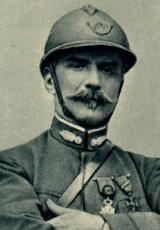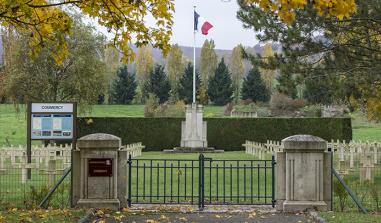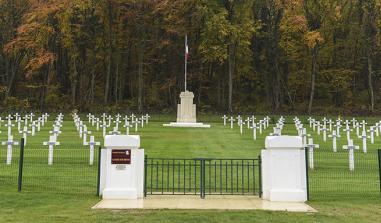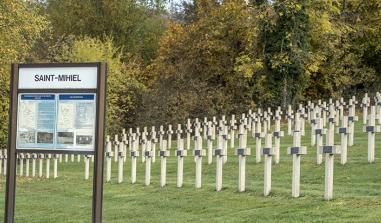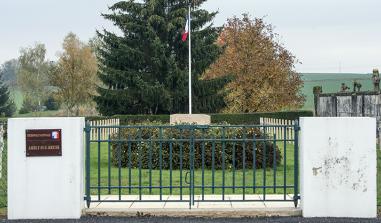Colonel Driant's Division

PC du Colonel Driant. Source : Site maginot60.com
The orders were to keep going until the end. Colonel Driant asks to join the front and is put in charge of two battalions of chasseurs north of Verdun.
21-22 February 1916
The orders were to keep going until the end. They had been obeyed. The deputy for Drancy, Colonel Driant, asked to join the front as appropriate to his rank and is put in charge of a half-brigade making up a corps of two battalions of chasseurs: the 56th and the 59th reservist battalions, north of Verdun. Driant, a politician as well as an officer, always spoke his mind, and wasted no time observing and commenting on the organization of the Verdun section. Not that his comments stopped the attempts to dismantle the fortifications of the town, even though intermediary positions had barely been considered. Commanding his chasseurs with an affected simplicity that was not without rigour, he could do nothing but organize his section and wait for a storm that, with cruel clarity, he had foreseen. From 20 January, Driant had been talking about this final test in his agenda to his half-brigade. Here is that text, with the lines that predict the unprecedented form that the battle to come will take underlined. Agenda - 20 January 1916 "The time has come for the two battalions to prepare themselves for action, and for every man to think about the role that has fallen to him. It is imperative at every level we have that in a battle as piecemeal as the one ahead, not one man uses the lack of orders as an excuse to do nothing". Communication was frequently interrupted, and soldiers often found themselves left to their own devices. Resisting and stopping the enemy by any means necessary had to be the predominant thought in the minds of each and every chausseur, especially when they were reminded that only the injured had been left in the hands of the enemy in any of the battles they'd been in over the past 17 months. The chausseurs did not surrender. On February 21, he got up early and looked up at a dazzling sun in a magnificent sky. He took off his wedding ring and gave it to his secretary. "If I'm killed, please bring this to Madame Driant." He mounted his horse at Bois des Caures, and was followed by his groom. It was 6.45am, and he went to the worksite where a reserve company under the leadership of Lieutenant Leroy and Lieutenant Simon were building a tunnel. He made them stop their work and sent them to the battlefield. While he was talking with a couple of officers, the first shell exploded: the tragedy had begun. The humid terrain of Bois des Caures (in local patois, caures means hazelnut tree) was not easily adapted to being hollowed out for such heavily trafficked trenches. The 56th and the 59th BCP had organized a system of redoubts, but their tragic weakness was gabionade. This was the state of play when he experienced the shock of February 21, 1916. The Bois des Caures and the bois d'Haumont to its left were right in the Germans' offensive axis. The bombing destroyed the fragile entrenched positions in the face of 150, 210 and 305. Driant himself had even written the night before, "they might attack tonight or they might wait another few days."
The Battle of Verdun Begins
By February 1916, Lieutenant-Colonel Driant's group of chausseurs had been occupying the Bois des Caures section since November. The group was made of the 56th reservist battalion (Captain Vincent) and the 59th reservist battalion (Commander Renouard). For several weeks, on the orders of Driant (who wanted an attack to be imminent), the two battalions had been alternating on the front, strengthening their positions and improving their defences. At 7am on 21 February 1916, the first shell was fired on the forest and Driant, knowing that the time for sacrifice had come, appeared amidst his chasseurs. He was never to leave them again. The bombing became so intense that the entire battlefield was covered in mines. From 10am, it was impossible, total chaos. At 5pm the bombing suddenly stopped, then firing began again, extended this time. It was rapid fire, often hand-to-hand combat. Despite extraordinary displays of heroism, several trenches were taken. By nightfall, the enemy had control of some of the front trenches. But chasseurs from Robin's company counter-attacked in the cold night, took back their trenches and sowed panic in the hearts of the Germans, who thought that the chausseurs had all been taken out of combat. Colonel Driant toured the section around midnight, going to the farthest trenches to encourage each and every one of his men.
On morning of February 22, while the chasseurs were taking back the trenches they lost the previous night, they were also within grenade range of the enemy. At 7am, bombing began, as intense as it was the day before. At midday it stopped. The surviving chasseurs ran to their posts. Their Colonel was amongst them, he took a gun and fired the first shot. The Bois de Caures could no longer serve for cover. It was surrounded by the enemy. Three companies at the front were taken down by two regiments and died at their posts. Seguin's company worked wonders. They fought with grenades until they were all gone, then with stones, then with the butts of their revolvers. At 1pm, there was a fresh attack. Driant, still with a gun in his hand,was atop his command post with his liasion officers. He was on top form. A superior marksman, he announced the results of the combat and aiming errors. SIMON's company counter-attacked, even taking prisoners. At 4pm, only about 80 men remained around Colonel Driant, Commander Renouard and Captain Vincent. Suddenly, shells started coming from behind. So the Bois de Caures was taken. It was the end. In the hope that he could continue to fight elsewhere, rather than going to prison, Colonel Driant decided to retreat behind the wood. They left in three groups -- the Colonel's group contained the liaison officers and the telegraphers. Everyone forced himself to jump from shell hole to shell hole, while a German 77 fired the whole time. The Colonel walked calmly, taking the rear, with his cane in his hand. He had just put a temporary bandage on a wounded chasseur when he is hit by a shower of bullets. "Oh my! My God!" he shouts. The Minister for Nancy was brought down by the enemy on this patch of Lorraine soil. Of the 1200 chausseurs in Driant's charge who fought against the 18th German army corps, only about 100 remain. The Krönprinz was expecting the battle to last just a few hours. This unforeseen two day setback gave the reserves time to arrive. Verdun would not fall. This commemorative plaque was a gift from the "Lieutenant Colonel Driant" class from Saint-Cyr on the occasion of their 20th anniversary and the 70th anniversary of their patron's death.
Battles of the Right Bank 1874-1914 - Verdun: border town
Verdun, transformed into border post when Alsace-Lorraine is annexed in 1871, quickly became the key piece in General Séré de Rivière's plan of defence for the eastern border. The elevated areas around the town and its strong but diminutive citadel were doubly fortified between 1874 and 1914 with concrete shells and armour-clad turrets. The main structure extended over a permitre of 45 km, consisting of forts and fortifications. Smaller elements punctuated the landscape (combat shelters, ammunition magazines, entrenchments, artillery positions) offered support. This impenetrable shield held around 66 000 men during wartime, boasted 185km of narrow military rail track, houses barracks, arsenals, training grounds, an airship park and an airforce camp. While pivotal to the French war effort in 1914, it was largely stripped of its defences the following year, when the Germans launched the "judgement" offensive -- a quick, brutal, and decisive blow.
1916 - Verdun, a ten-month battle
For 300 days and 300 nights, on the little pocket of fortified land known as the Hauts de Meuse, the largest battle history had ever known brought together humans and materials in numbers never before seen, and constituted a turning point in the Great War. It was here, in this hellish crucible constantly bombarded by 60 million shells, where 300 000 men died or disappeared and 450 000 were injured, that the soldier at Verdun lived and died. French and German, alone or in small groups, abandoned in shell holes filled with dead bodies, poorly nourished, faced with cold, thirst, and mud, with fear, with madness and dispair for company and orders simply to attack or defend. From 21 February on, the shower of "Trommelfeuer" shells hacked at the French positions. In the destroyed Bois des Caures, even a 36 hour long fight could not stop the assault. On 25 February, Fort Douaumont was taken. The situation became critical, and the likely fall of Verdun caused the last remaining civilians to make their escape. On the 26th, the newly appointed General Pétain decided to fight a defensive battle on site: he reorganised positions, rearmed the forts, and sent men and supplies to the front via the Voie Sacrée. The offensive was limited by the desperate sacrifices of soldiers, and ran out of steam. In March, Falkenhay, the German commander in chief, increased his attack on the left bank: there was an intense battle at Avocourt, on the slopes of Mort-Homme and Cote 304. On the other bank, on those sections of Vaux and Caillette whose bitterly fought ravines came to be known as "ravines of death," the front wavered but did not cede. Cote 304 and the lines of defence at Mort-Homme and Cumières were taken in May, but every metre lost or gained iwas done so at the cost of massive losses of life. Fort Vaux, which is attacked on 9 March and taken on 7 June, instigates a death cry that quickly reaches the Franco-British offensive on the Somme. On 23 June, 50 000 German soldiers marched on the final hills leading to Verdun, occupiemont Thiaumont and the destroyed town of Fleury but fail to take Froideterre. On the 11 and 12 July, at the same time as the offensive was launched on the Somme, a final German attack came to an end outside Fort Vaux, just 4km from Verdun. This confirms the impossibility of predicting the final outcome of this war. Once the German offensive had been stopped, the other side took the initiative. Fleury was retaken on 17 August, and throughout the autumn the attempts to reconquer meant that danger was redirected away from Verdun. Fort Douaumont was reclaimed on 24 October, Vaux on 2 November. By December, most of the lost terrain had been retaken. But it would take another two years, and the support of the Americans in 1918, to get the front back to the Bois des Caures.
From the Argonne to Saint-Mihiel, four years "under Verdun"
From the Argonne to Saint-Mihiel, four years "under Verdun" The war was developing in the Meuse as early as August 1914, circumnavigating then isolating the fortified town of Verdun. After the terrible affair at Vaubécourt-la-Vaux-Marie on 10 September, the front was positioned on the Argonne's barrier massif. The violent battles at Hauts de Meuse between the 20th and the 25th led to a Salient being built around Saint-Mihiel, cutting off the Meuse and its roads and rail 30km from Verdun. Resistance at Fort Troyon meant that it could not be totally surrounded. For four years, the "hills," ridges and mounds around Verdun were the site of horrific battles. Underground, in the earth at Eparges and Vauquois, enormous funnels bear witness to the mine war and the explosions that swallowed up men and trenches alike. Only in the autumn of 1918, when two American offensives and the sacrifice of 120 000 "Sammies" loosens the net, could the Saint-Mihiel Salient be retaken and the Meuse-Argonne region come back under French control.
LeDriant's many graves
According to the 23 March 1916 report of chasseur Paul Coisne of the 56th reservist battalion, interned at Camp Cassel and witness to Lieutenant-Colonel Driant's final moments, his last words were "Oh ! là, là, mon Dieu !" ("Oh my! My God!")
Baronness Schrotter of Wiesbaden sent a condolence letter to Madame Driant via a Swiss intermediary on 16th March 1916. She wrote: "My son, an Artillery Lieutenant who fought next to your husband, asked me to write to you and to tell you that Monsieur Driant has been buried with every respect and every care, and that his enemy comrades dug him a handsome grave, and decorated it (...). They are going to look after the grave, so that you will be able to visit it when peace comes (...)". Maurice Barrès, quoting this letter dated 9th March 1916, wrote the following in the Echo de Paris: "Here is the German letter that ends the life of a great French man." Lieutenant-Colonel Driant is remembered with pride in the Tomb of the Brave at the musée des Chasseurs, which is housed at the service historique de l'armée de terre at Vincennes. The story of Driant's many graves is a complicated one. After his death, the Germans buried him on the battlefield. It wasn't until 9th August 1919 that he was exhumed, identified and then buried again at the same location. He was exhumed again on 9th October 1922, with the aim of transporting his body to the Bois des Caures monument. This happened on 21st October, the day before the monument was inaugurated.
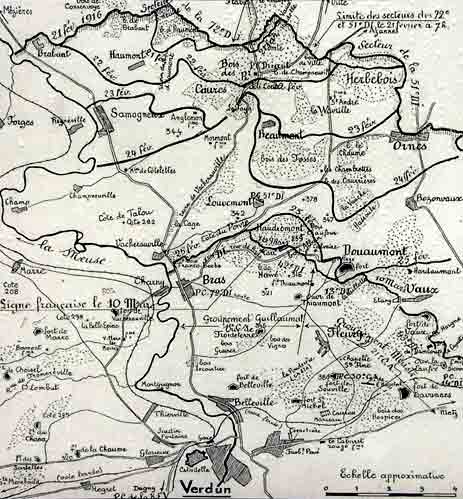
German attack from 21 to 25 February 1916. Source : Conseil Général de la Meuse.
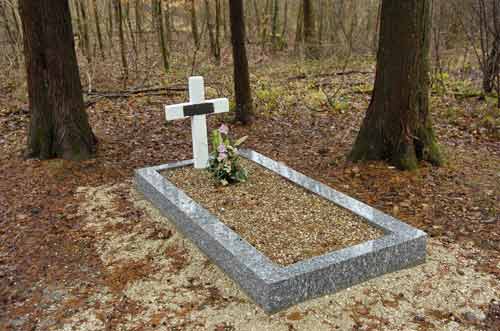
Colonel Driant's tomb. Photo JP le Padellechoto JP le Padellec
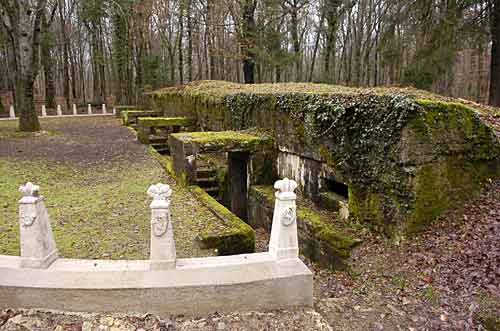
Colonel Dryant's Division. Photo JP le Padellec.
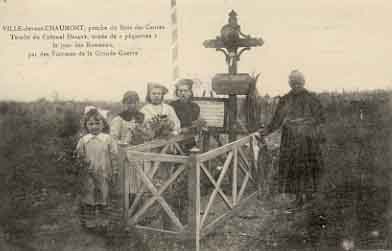
Ancienne tombe du colonel Driant. 1927 Recto. Source : Collection privée
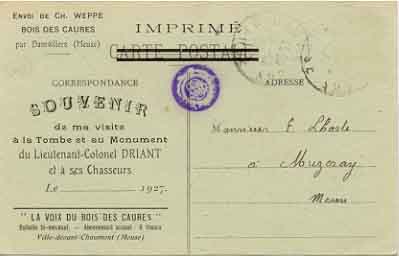
Ancienne tombe du colonel Driant. 1927 Verso. Source : Collection privée
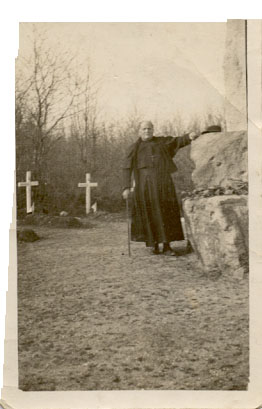
L'abbé Weppe. Recto. Source : Collection privée
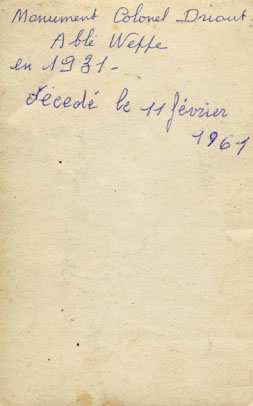
L'abbé Weppe. Verso. Source : Collection privée
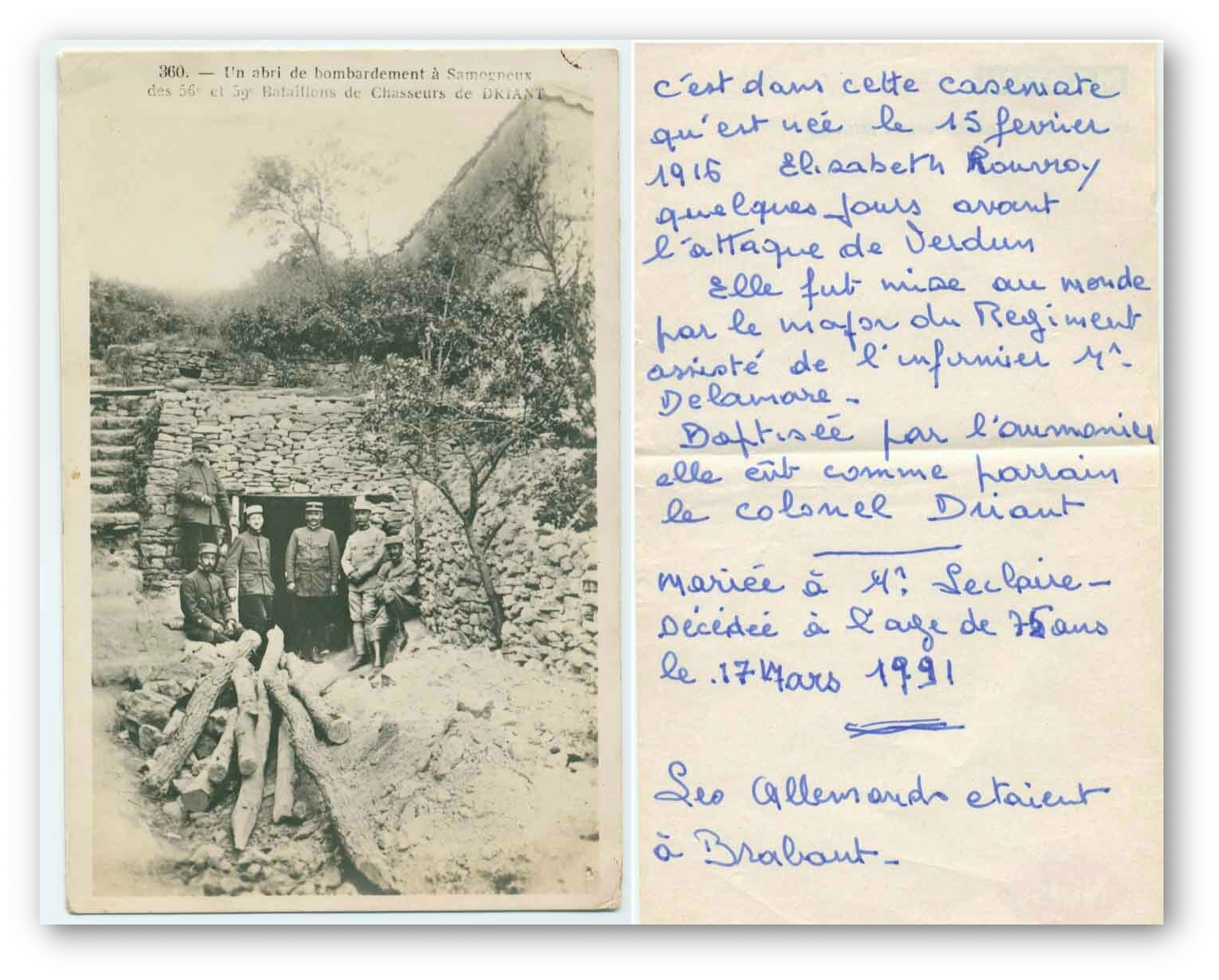
Abri de Samogneux en 1916. Source : Collection privée
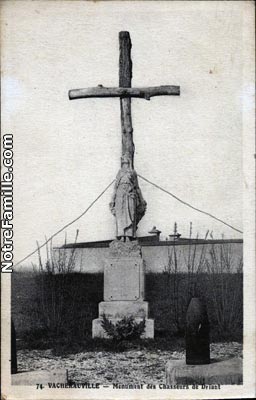
Monument des Chasseurs de Driant à Vacherauville. Source : Carte postale, collection privée
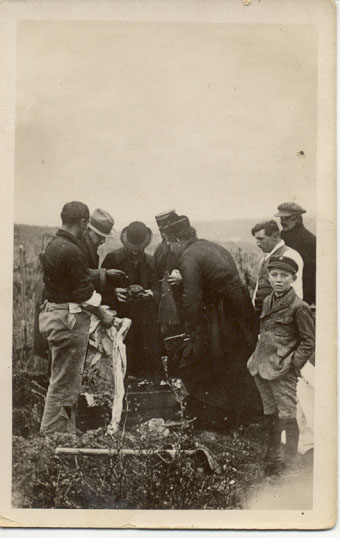
Examen du crâne du colonel Driant. Recto. Source : Collection privée
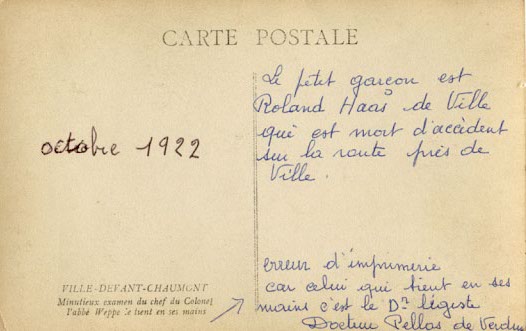
Examen du crâne du colonel Driant. Verso. Source : Collection privée
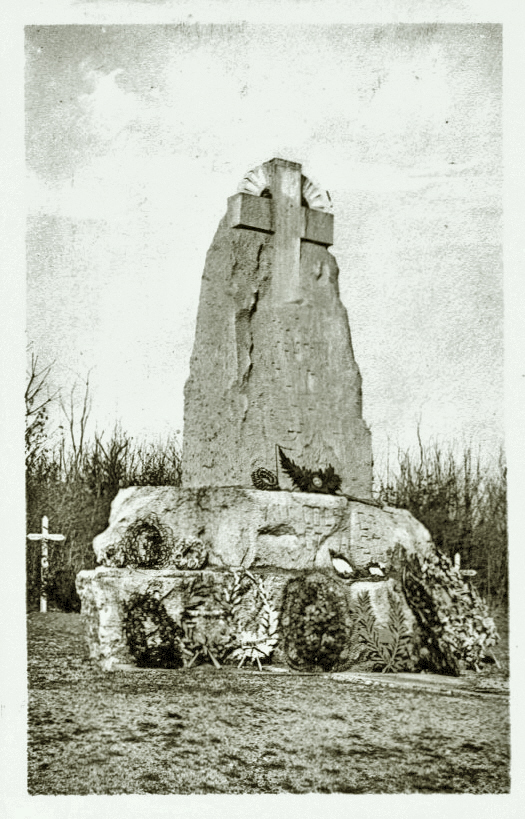
Mémorial du colonel Driant. Source : Collection privée
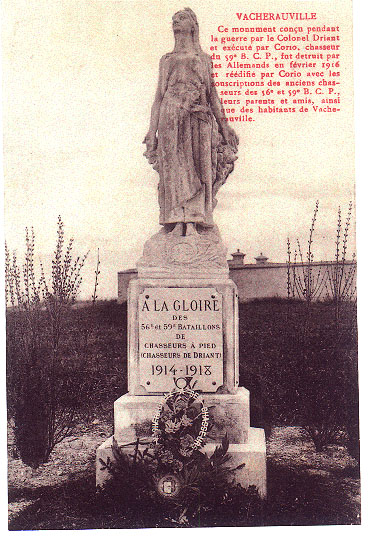
Monument de Vacherauville. Source : Collection privée
Practical information
55100
Haumont-près-Samogneux
Accessible toute l'année


